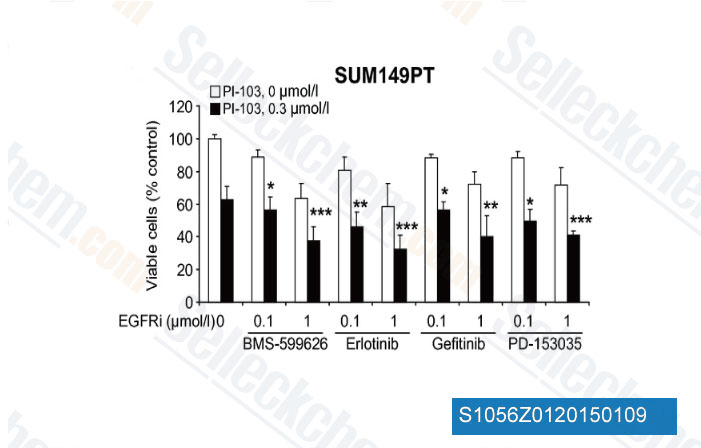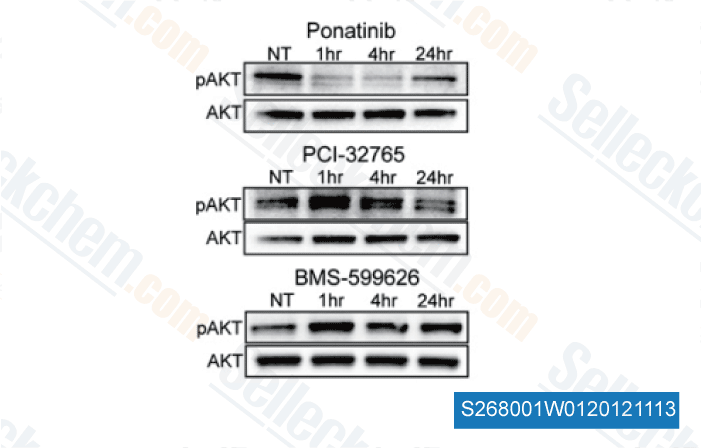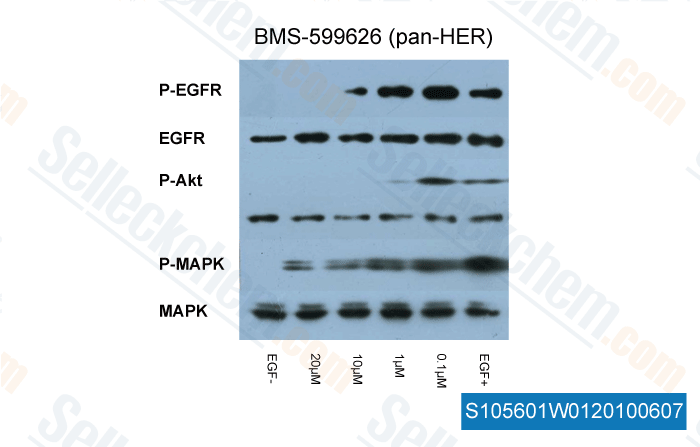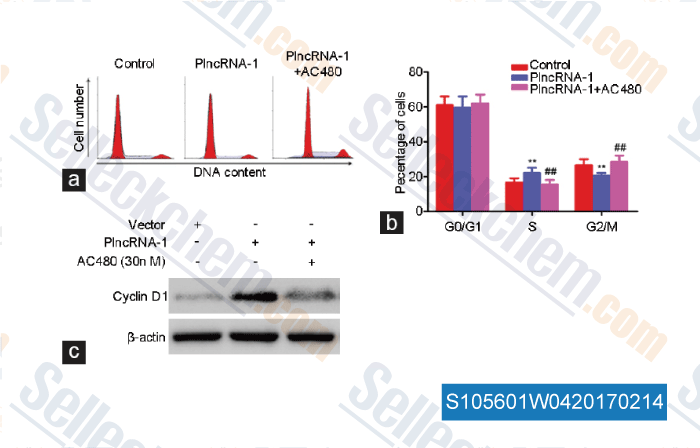|
Toll Free: (877) 796-6397 -- USA and Canada only -- |
Fax: +1-832-582-8590 Orders: +1-832-582-8158 |
Tech Support: +1-832-582-8158 Ext:3 Please provide your Order Number in the email. |
Technical Data
| Formula | C27H27FN8O3 |
|||
| Molecular Weight | 530.55 | CAS No. | 714971-09-2 | |
| Solubility (25°C)* | In vitro | DMSO | 113 mg/mL (212.98 mM) | |
| Ethanol | 20 mg/mL (37.69 mM) | |||
| Water | Insoluble | |||
|
* <1 mg/ml means slightly soluble or insoluble. * Please note that Selleck tests the solubility of all compounds in-house, and the actual solubility may differ slightly from published values. This is normal and is due to slight batch-to-batch variations. * Room temperature shipping (Stability testing shows this product can be shipped without any cooling measures.) |
||||
Preparing Stock Solutions
Biological Activity
| Description | AC480 (BMS-599626) is a selective and efficacious inhibitor of HER1 and HER2 with IC50 of 20 nM and 30 nM, ~8-fold less potent to HER4, >100-fold to VEGFR2, c-Kit, Lck, MET etc. Phase 1. | ||||||
|---|---|---|---|---|---|---|---|
| Targets |
|
||||||
| In vitro | BMS-599626 also inhibits the related receptor HER4, but with reduced potency with IC50 of 190 nM. BMS-599626 is identified as an ATP-competitive inhibitor for HER1 and as an ATP-noncompetitive inhibitor for HER2 with Ki of 2 nM and 5 nM, respectively. BMS-599626 inhibits the proliferation of tumor cells expressing high levels of HER1 and/or HER2, including Sal2, BT474, N87, KPL-4, HCC202, HCC1954, HCC1419, AU565, ZR-75-30, MDA-MB-175, GEO, and PC9 cells with IC50 of 0.24 μM, 0.31 μM, 0.45 μM, 0.38μM, 0.94 μM, 0.34 μM, 0.75 μM, 0.63 μM, 0.51 μM, 0.84 μM, 0.90 μM and 0.34 μM, respectively. While the proliferation of the ovarian tumor cell line A2780 and MRC5 fibroblasts, neither of which expresses HER1 or HER2, are not inhibited significant by BMS-599626. [1] A recent study shows that BMS-599626 significantly enhances the radiosensitivity of HN-5 cells expressing both EGFR and Her2 cell, by promoting cycle redistribution and inhibiting DNA repair. [2] | ||||||
| In vivo | In vivo, oral administration of BMS-599626 results in a dose-dependent inhibition of Sal2 tumor growth at doses ranging from 60 mg/kg to 240 mg/kg, yielding a potent antitumor activity in a human breast tumor KPL-4 xenograft at its maximum tolerated dose of 180 mg/kg, and also has similar antitumor activity in other HER2 amplified xenograft models, as well as other HER1-overexpressing xenograft models. [1] |
Protocol (from reference)
| Kinase Assay:[1] |
|
|---|---|
| Cell Assay:[1] |
|
| Animal Study:[1] |
|
References
|
Customer Product Validation

-
Data from [J Cell Mol Med, 2013, 17(5), 648-56]

-
Data from [Cancer Cell, 2012, 22(5), 656-667 ]

-
, 2010, Dr. Zhang of Tianjin Medical University

-
, , Asian J Androl, 2017, 19(4):453-457
Selleck's AC480 (BMS-599626) has been cited by 10 publications
| Deciphering the Role and Signaling Pathways of PKCα in Luminal A Breast Cancer Cells [ Int J Mol Sci, 2022, 23(22)14023] | PubMed: 36430510 |
| Comprehensive pharmacogenomic characterization of gastric cancer. [ Genome Med, 2020, 18;12(1):17] | PubMed: 32070411 |
| The AXL receptor tyrosine kinase is associated with adverse prognosis and distant metastasis in esophageal squamous cell carcinoma. [Hsieh MS, et al. Oncotarget, 2016, 7(24):36956-36970] | PubMed: 27172793 |
| Gain- and Loss-of-Function Mutations in the Breast Cancer Gene GATA3 Result in Differential Drug Sensitivity [ PLoS Genet, 2016, 12(9):e1006279] | PubMed: 27588951 |
| PlncRNA-1 induces apoptosis through the Her-2 pathway in prostate cancer cells. [Yang Q, et al. Asian J Androl, 2016, 10.4103/1008-682X] | PubMed: 27232851 |
| [ Oncotarget, 2015, ] | PubMed: 25965827 |
| Synergistic apoptosis in head and neck squamous cell carcinoma cells by co-inhibition of insulin-like growth factor-1 receptor signaling and compensatory signaling pathways [Axelrod MJ, et al. Head Neck, 2014, 10.1002/hed.23822.?] | PubMed: 24986420 |
| CDK4/6 inhibition provides a potent adjunct to Her2-targeted therapies in preclinical breast cancer models [Witkiewicz AK, et al. Genes Cancer, 2014, 5(7-8):261-72] | PubMed: 25221644 |
| Inhibition of the PI3K/AKT pathway potentiates cytotoxicity of EGFR kinase inhibitors in triple-negative breast cancer cells. [Yi YW, et al. J Cell Mol Med, 2013, 17(5):648-56] | PubMed: 23601074 |
| Crosstalk between ROR1 and the Pre-B Cell Receptor Promotes Survival of t (1; 19) Acute Lymphoblastic Leukemia. [Bicocca VT, et al. Cancer Cell, 2012, 22(5):656-67] | PubMed: 23153538 |
RETURN POLICY
Selleck Chemical’s Unconditional Return Policy ensures a smooth online shopping experience for our customers. If you are in any way unsatisfied with your purchase, you may return any item(s) within 7 days of receiving it. In the event of product quality issues, either protocol related or product related problems, you may return any item(s) within 365 days from the original purchase date. Please follow the instructions below when returning products.
SHIPPING AND STORAGE
Selleck products are transported at room temperature. If you receive the product at room temperature, please rest assured, the Selleck Quality Inspection Department has conducted experiments to verify that the normal temperature placement of one month will not affect the biological activity of powder products. After collecting, please store the product according to the requirements described in the datasheet. Most Selleck products are stable under the recommended conditions.
NOT FOR HUMAN, VETERINARY DIAGNOSTIC OR THERAPEUTIC USE.
